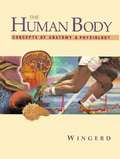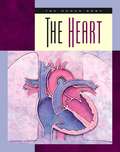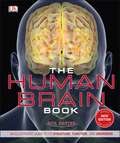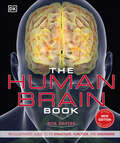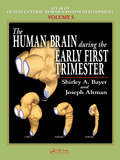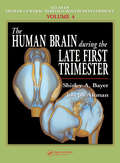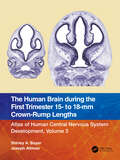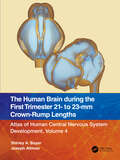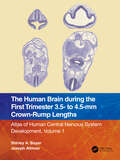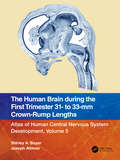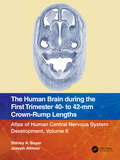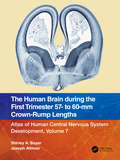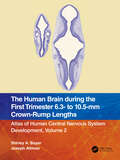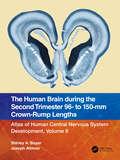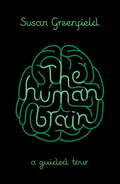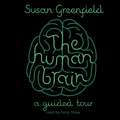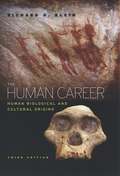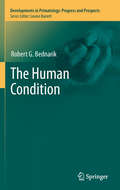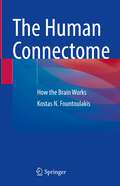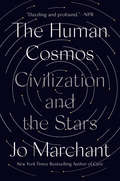- Table View
- List View
The Human Body: Concepts Of Anatomy And Physiology
by Bruce D. WingerdThis text is developed specifically for the one-term market and offers the essentials of anatomy and physiology in a direct, concise format. Students benefit from striking and precise full-color art that enhances the author's straightforward, clear writing style. The author's vast teaching experience enables him to accurately present the appropriate vocabulary and detail that an allied health/physical education major needs.
The Human Body: The Heart
by Susan H. GrayThis book talks about all the interesting details about one of the most important organs in the human body -- heart.
The Human Brain Book
by Rita CarterThis award-winning science book uses the latest findings from neuroscience research and brain-imaging technology to take you on a journey into the human brain. The book answers fundamental and compelling questions about the brain: what does it mean to be conscious, what happens when we're asleep, and are the brains of men and women different? The Human Brain Book provides an up-to-date guide to one of science's most exciting frontiers. With its coverage of more than 50 brain-related diseases and disorders--from strokes to brain tumors and schizophrenia--it is also an essential manual for students and healthcare professionals.
The Human Brain Book: An Illustrated Guide to its Structure, Function, and Disorders (DK Human Body Guides)
by Rita CarterThe Human Brain Book is a complete guide to the one organ in the body that makes each of us what we are - unique individuals. It combines the latest findings from the field of neuroscience with expert text and state-of-the-art illustrations and imaging techniques to provide an incomparable insight into every facet of the brain. Layer by layer, it reveals the fascinating details of this remarkable structure, covering all the key anatomy and delving into the inner workings of the mind, unlocking its many mysteries, and helping you to understand what's going on in those millions of little gray and white cells. Tricky concepts are illustrated and explained with clarity and precision, as The Human Brain Book looks at how the brain sends messages to the rest of the body, how we think and feel, how we perform unconscious actions (for example breathing), explores the nature of genius, asks why we behave the way we do, explains how we see and hear things, and how and why we dream. Physical and psychological disorders affecting the brain and nervous system are clearly illustrated and summarized in easy-to-understand terms. The unique DVD brings the subject to life with interactive elements. These include a clickable model of the brain's structure that allows the user to zoom in and discover deeper layers of detail, while complex processes, such as the journey of a nerve impulse, are broken down and simplified through intuitive animations.
The Human Brain During the Early First Trimester (Atlas of Human Central Nervous System Development)
by Shirley A. Bayer Joseph AltmanThis is the fifth and last Volume in the Atlas of Human Central Nervous System Development Series. It deals with human brain development during the early first trimester from the third through the seventh gestational weeks. Serial sections from 14 specimens are illustrated and annotated in detail, together with 3?D reconstructions of the brains of
The Human Brain During the Late First Trimester
by Shirley A. Bayer Joseph AltmanThe fourth volume in the Atlas of Human Central Nervous System Development series, The Human Brain During the Late First Trimester provides new information about features of the perinatal brain. It deals with brain development during the late first trimester (GW11-GW7.5). The major theme of this volume is the identification of stretches and patches
The Human Brain during the First Trimester 15- to 18-mm Crown-Rump Lengths: Atlas of Human Central Nervous System Development, Volume 3
by Shirley A. Bayer Joseph AltmanThis third of 15 short atlases reimagines the classic 5-volume Atlas of Human Central Nervous System Development. This volume presents serial sections from specimens between 15 mm and 18 mm with detailed annotations, together with 3D reconstructions. An introduction summarizes human CNS development by using high-resolution photos of methacrylate-embedded rat embryos at a similar stage of development as the human specimens in this volume. The accompanying Glossary gives definitions for all the terms used in this volume and all the others in the Atlas. Features Classic anatomical atlas Detailed labeling of structures in the developing brain offers updated terminology and the identification of unique developmental features, such as germinal matrices of specific neuronal populations and migratory streams of young neurons Appeals to neuroanatomists, developmental biologists, and clinical practitioners A valuable reference work on brain development that will be relevant for decades
The Human Brain during the First Trimester 21- to 23-mm Crown-Rump Lengths: Atlas of Human Central Nervous System Development, Volume 4
by Shirley A. Bayer Joseph AltmanThis fourth of 15 short atlases reimagines the classic 5-volume Atlas of Human Central Nervous System Development. This volume presents serial sections from specimens between 21 mm and 23 mm with detailed annotations, together with 3D reconstructions. An introduction summarizes human CNS development by using high-resolution photos of methacrylate-embedded rat embryos at a similar stage of development as the human specimens in this volume. The accompanying Glossary gives definitions for all the terms used in this volume and all the others in the Atlas. Key Features Classic anatomical atlases Detailed labeling of structures in the developing brain offers updated terminology and the identification of unique developmental features, such as, germinal matrices of specific neuronal populations and migratory streams of young neurons Appeals to neuroanatomists, developmental biologists, and clinical practitioners. A valuable reference work on brain development that will be relevant for decades
The Human Brain during the First Trimester 3.5- to 4.5-mm Crown-Rump Lengths: Atlas of Human Central Nervous System Development, Volume 1
by Shirley A. Bayer Joseph AltmanThis first of 15 short atlases reimagines the classic 5-volume Atlas of Human Central Nervous System Development. This volume presents serial sections from specimens between 3.5 mm and 4.5 mm with detailed annotations, together with 3D reconstructions. An introduction summarizes human CNS development by using high-resolution photos of methacrylate-embedded rat embryos at a similar stage of development as the human specimens in this volume. The accompanying Glossary gives definitions for all the terms used in this volume and all the others in the Atlas. Features Classic anatomical atlas Detailed labeling of structures in the developing brain offers updated terminology and the identification of unique developmental features, such as germinal matrices of specific neuronal populations and migratory streams of young neurons Appeals to neuroanatomists, developmental biologists, and clinical practitioners A valuable reference work on brain development that will be relevant for decades
The Human Brain during the First Trimester 31- to 33-mm Crown-Rump Lengths: Atlas of Human Central Nervous System Development, Volume 5
by Shirley A. Bayer Joseph AltmanThis fifth of 15 short atlases reimagines the classic 5-volume Atlas of Human Central Nervous System Development. This volume presents serial sections from specimens between 31 mm and 33 mm with detailed annotations, together with 3D reconstructions. An introduction summarizes human CNS development by using high-resolution photos of methacrylate-embedded rat embryos at a similar stage of development as the human specimens in this volume. The accompanying Glossary gives definitions for all the terms used in this volume and all the others in the Atlas. Features Classic anatomical atlases Detailed labeling of structures in the developing brain offers updated terminology and the identification of unique developmental features, such as, germinal matrices of specific neuronal populations and migratory streams of young neurons Appeals to neuroanatomists, developmental biologists, and clinical practioners A valuable reference work on brain development that will be relevant for decades
The Human Brain during the First Trimester 40- to 42-mm Crown-Rump Lengths: Atlas of Human Central Nervous System Development, Volume 6
by Shirley A. Bayer Joseph AltmanThis sixth of 15 short atlases reimagines the classic 5-volume Atlas of Human Central Nervous System Development. This volume presents serial sections from specimens between 40 mm and 42 mm with detailed annotations, together with 3D reconstructions. An introduction summarizes human CNS development by using high-resolution photos of methacrylate-embedded rat embryos at a similar stage of development as the human specimens in this volume. The accompanying Glossary gives definitions for all the terms used in this volume and all the others in the Atlas. Features Classic anatomical atlas Detailed labeling of structures in the developing brain offers updated terminology and the identification of unique developmental features, such as, germinal matrices of specific neuronal populations and migratory streams of young neurons Appeals to neuroanatomists, developmental biologists, and clinical practitioners A valuable reference work on brain development that will be relevant for decades
The Human Brain during the First Trimester 57- to 60-mm Crown-Rump Lengths: Atlas of Human Central Nervous System Development, Volume 7
by Shirley A. Bayer Joseph AltmanThe seventh of 15 short atlases reimagining the classic 5-volume Atlas of Human Central Nervous System Development. This volume presents serial sections from specimens between 57 mm and 60 mm with detailed annotations, together with 3D reconstructions. An introduction summarizes human CNS development by using high-resolution photos of methacrylate-embedded rat embryos at a similar stage of development as the human specimens in this volume. The accompanying Glossary gives definitions for all the terms used in this volume and all the others in the Atlas. Features • Classic anatomical atlas • Detailed labeling of structures in the developing brain offers updated terminology and the identification of unique developmental features, such as, germinal matrices of specific neuronal populations and migratory streams of young neurons • Appeals to neuroanatomists, developmental biologists, and clinical practitioners • A valuable reference work on brain development that will be relevant for decades
The Human Brain during the First Trimester 6.3- to 10.5-mm Crown-Rump Lengths: Atlas of Human Central Nervous System Development, Volume 2
by Shirley A. Bayer Joseph AltmanThis second of 15 short atlases reimagines the classic 5-volume Atlas of Human Central Nervous System Development. This volume presents serial sections from specimens between 6.3 mm and 10.5 mm with detailed annotations, together with 3D reconstructions. An introduction summarizes human CNS development by using high-resolution photos of methacrylate-embedded rat embryos at a similar stage of development as the human specimens in this volume. The accompanying Glossary gives definitions for all the terms used in this volume and all the others in the Atlas. Features Classic anatomical atlas Detailed labeling of structures in the developing brain offers updated terminology and the identification of unique developmental features, such as, germinal matrices of specific neuronal populations and migratory streams of young neurons Appeals to neuroanatomists, developmental biologists, and clinical practitioners A valuable reference work on brain development that will be relevant for decades
The Human Brain during the Second Trimester 160– to 170–mm Crown-Rump Lengths: Atlas of Human Central Nervous System Development, Volume 9
by Shirley A. Bayer Joseph AltmanThis ninth of 15 short atlases reimagines the classic 5-volume Atlas of Human Central Nervous System Development. This volume presents serial sections from specimens between 160 mm and 170 mm with detailed annotations. An introduction summarizes human CNS developmental highlights around 5 months of gestation. The Glossary (available separately) gives definitions for all the terms used in this voume and all the others in the Atlas. Features • Classic anatomical atlas • Detailed labeling of structures in the developing brain offers updated terminology and the identification of unique developmental features, such as germinal matrices of specific neuronal populations and migratory streams of young neurons • Appeals to neuroanatomists, developmental biologists, and clinical practitioners • A valuable reference work on brain development that will be relevant for decades
The Human Brain during the Second Trimester 190– to 210–mm Crown-Rump Lengths: Atlas of Human Central Nervous System Development, Volume 10
by Shirley A. Bayer Joseph AltmanThis tenth of 15 short atlases reimagines the classic 5-volume Atlas of Human Central Nervous System Development. This volume presents serial sections from specimens between 190 mm and 210 mm with detailed annotations. An introduction summarizes human CNS developmental highlights around 5 months of gestation. The Glossary (available separately) gives definitions for all the terms used in this volume and all the others in the Atlas. Features • Classic anatomical atlas • Detailed labeling of structures in the developing brain offers updated terminology and the identification of unique developmental features, such as germinal matrices of specific neuronal populations and migratory streams of young neurons • Appeals to neuroanatomists, developmental biologists, and clinical practitioners • A valuable reference work on brain development that will be relevant for decades
The Human Brain during the Second Trimester 96– to 150–mm Crown-Rump Lengths: Atlas of Human Central Nervous System Development, Volume 8
by Shirley A. Bayer Joseph AltmanThis eighth of 15 short atlases reimagines the classic 5-volume Atlas of Human Central Nervous System Development. This volume presents serial sections from specimens between 96 mm and 150 mm with detailed annotations. An introduction summarizes human CNS developmental highlights between 3.5 and 4.5 months of gestation. The accompanying Glossary (available free online) gives definitions for all the labels used in this volume and all the others in the Atlas. Key Features • Classic anatomical atlas • Detailed labeling of structures in the developing brain offers updated terminology and the identification of unique developmental features such as germinal matrices of specific neuronal populations and migratory streams of young neurons • Appeals to neuroanatomists, developmental biologists, and clinical practitioners • A valuable reference work on brain development that will be relevant for decades
The Human Brain during the Third Trimester 225– to 235–mm Crown-Rump Lengths: Atlas of Central Nervous System Development, Volume 11
by Shirley A. Bayer Joseph AltmanThis eleventh of 15 short atlases reimagines the classic 5-volume Atlas of Human Central Nervous System Development. This volume presents serial sections from specimens between 225 mm and 235 mm with detailed annotations. An introduction summarizes human CNS developmental highlights around 6.5 months of gestation. The Glossary (available separately) gives definitions for all the terms used in this volume and all the others in the Atlas. Key Features • Classic anatomical atlases • Detailed labeling of structures in the developing brain offers updated terminology and the identification of unique developmental features, such as germinal matrices of specific neuronal populations and migratory streams of young neurons • Appeals to neuroanatomists, developmental biologists, and clinical practitioners • A valuable reference work on brain development that will be relevant for decades
The Human Brain during the Third Trimester 260– to 270–mm Crown-Rump Lengths: Atlas of Central Nervous System Development, Volume 12
by Shirley A. Bayer Joseph AltmanThis twelfth of 15 short atlases reimagines the classic 5-volume Atlas of Human Central Nervous System Development. This volume presents serial sections from specimens between 260 mm and 270 mm with detailed annotations. An introduction summarizes human CNS developmental highlights around 6.5 months of gestation. The Glossary (available separately) gives definitions for all the terms used in this volume and all the others in the Atlas. Key Features • Classic anatomical atlases • Detailed labeling of structures in the developing brain offers updated terminology and the identification of unique developmental features, such as germinal matrices of specific neuronal populations and migratory streams of young neurons • Appeals to neuroanatomists, developmental biologists, and clinical practitioners • A valuable reference work on brain development that will be relevant for decades
The Human Brain during the Third Trimester 310– to 350–mm Crown-Rump Lengths: Atlas of Central Nervous System Development, Volume 13
by Shirley A. Bayer Joseph AltmanThis thirteenth of 15 short atlases reimagines the classic 5 volume Atlas of Human Central Nervous System Development. This volume presents serial sections from specimens between 310 mm and 350 mm with detailed annotations. An introduction summarizes human CNS developmental highlights around 9 months of gestation. The Glossary (available separately) gives definitions for all the terms used in this volume and all the others in the Atlas. Key Features • Classic anatomical atlases • Detailed labeling of structures in the developing brain offers updated terminology and the identification of unique developmental features, such as germinal matrices of specific neuronal populations and migratory streams of young neurons • Appeals to neuroanatomists, developmental biologists, and clinical practitioners • A valuable reference work on brain development that will be relevant for decades
The Human Brain: A Guided Tour (SCIENCE MASTERS)
by Susan GreenfieldSusan Greenfield, one of the world's pre-eminent scientists, takes the reader on a guided tour of the final frontier in human understanding: the brain.Locked away remote from the rest of the body in its own custom-built casing of skull bone, with no intrinsic moving parts, the human brain remains a tantalising mystery. But now, more than ever before, we have the expertise to tackle this mystery - the last 20 years have seen astounding progress in brain research. Susan Greenfield begins by exploring the roles of different regions of the brain. She then switches to the opposite direction and examines how certain functions, such as movement and vision, are accommodated in the brain. She describes how a brain is made from a single fertilized egg, and the fate of the brain is traced through life as we see how it constantly changes as a result of experience to provide the essence of a unique individual.
The Human Brain: A Guided Tour (SCIENCE MASTERS)
by Susan GreenfieldLocked away remote from the rest of the body in its own custom-built casing of skull bone, with no intrinsic moving parts, the human brain remains a tantalising mystery. But now, more than ever before, we have the expertise to tackle this mystery - the last 20 years have seen astounding progress in brain research. Susan Greenfield begins by exploring the roles of different regions of the brain. She then switches to the opposite direction and examines how certain functions, such as movement and vision, are accommodated in the brain. She describes how a brain is made from a single fertilized egg, and the fate of the brain is traced through life as we see how it constantly changes as a result of experience to provide the essence of a unique individual.A bite-sized science classic, read by Fiona Shaw(p) 1997 Orion Publishing Group
The Human Career: Human Biological and Cultural Origins (3rd edition)
by Richard G. KleinKlein (anthro, U. of Chicago) summarizes our current knowledge and ongoing debates about human evolution from the earliest primates to modern man. Both the fossil and archaeological evidence is examined, showing the relationship between human form and behavior.
The Human Condition
by Robert G. BednarikThis book summarizes the work of several decades, culminating in a revolutionary model of recent human evolution. It challenges current consensus views fundamentally, presenting in its support a mass of evidence, much of which has never been assembled before. This evidence derives primarily from archaeology, paleoanthropology, genetics, clinical psychology, neurosciences, linguistics and cognitive sciences. No even remotely similar thesis of recent human origins has ever been published, but some of the key elements of this book have been published by the author in major refereed journals in the last two years. Its implications are far-reaching and profoundly affect the way we perceive ourselves as a species. This book about what it means to be human is heavily referenced, with a bibliography of many hundreds of scientific entries.
The Human Connectome: How the Brain Works
by Kostas N. FountoulakisThis book constitutes the end result of 20 years-long effort that goes beyond a Psychiatrist’s standard clinical training and education, even that of a Psychiatrist that follows an academic career. Trying to explain how the human mind works is hard and the heterogeneity of the audience make the attempt even more difficult. There is a conceptual difference between the words ‘brain’ and ‘mind’and this makes the effort even more difficult since the present book tries to preserve the strict scientific approach concerning all the topics discussed. The work elaborates and tries to answer questions frequently phrased by audiences in teaching classes and in conferences and does not avoid any question. In order to achieve this goal, it is structured in chapters all the way from the molecule and the cell to consciousness and free will. The book targets mainly the mental health care professionals as an audience, and to a lesser extend the other health professionals. It is written according to the author’s view concerning the training and educational needs of Psychiatrists and Psychologists and to a lesser degree of Neurologists and Neuroscientists in general.
The Human Cosmos: Civilization and the Stars
by Jo Marchant"A tour de force on par with Sapiens by Yuval Noah Harari"—Booklist (starred review)"One to savor"—Publishers Weekly (starred review)An historically unprecedented disconnect between humanity and the heavens has opened. Jo Marchant's book can begin to heal it. For at least 20,000 years, we have led not just an earthly existence but a cosmic one. Celestial cycles drove every aspect of our daily lives. Our innate relationship with the stars shaped who we are--our art, religious beliefs, social status, scientific advances, and even our biology. But over the last few centuries we have separated ourselves from the universe that surrounds us. It's a disconnect with a dire cost. Our relationship to the stars and planets has moved from one of awe, wonder and superstition to one where technology is king--the cosmos is now explored through data on our screens, not by the naked eye observing the natural world. Indeed, in most countries modern light pollution obscures much of the night sky from view. Jo Marchant's spellbinding parade of the ways different cultures celebrated the majesty and mysteries of the night sky is a journey to the most awe inspiring view you can ever see--looking up on a clear dark night. That experience and the thoughts it has engendered have radically shaped human civilization across millennia. The cosmos is the source of our greatest creativity in art, in science, in life. To show us how, Jo Marchant takes us to the Hall of the Bulls in the caves at Lascaux in France, and to the summer solstice at a 5,000-year-old tomb at New Grange in Ireland. We discover Chumash cosmology and visit medieval monks grappling with the nature of time and Tahitian sailors navigating by the stars. We discover how light reveals the chemical composition of the sun, and we are with Einstein as he works out that space and time are one and the same. A four-billion-year-old meteor inspires a search for extraterrestrial life. The cosmically liberating, summary revelation is that star-gazing made us human.
